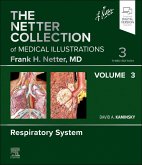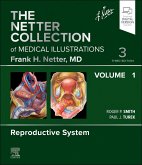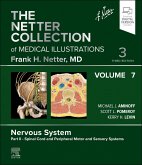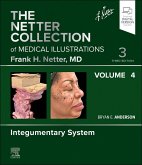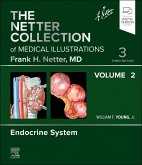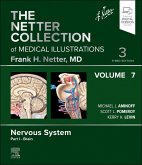- Gebundenes Buch
- Merkliste
- Auf die Merkliste
- Bewerten Bewerten
- Teilen
- Produkt teilen
- Produkterinnerung
- Produkterinnerung
Respiratory System, 2nd Edition provides a concise and highly visual approach to the basic sciences and clinical pathology of this body system. This volume in The Netter Collection of Medical Illustrations (the CIBA "Green Books") has been expanded and revised by Dr. David Kaminsky to cover important topics like pulmonary hypertension, COPD, asthma, drug-resistant TB, modern endoscopic and surgical techniques, and more. Classic Netter art, updated illustrations, and modern imaging make this timeless work essential to your library.
Andere Kunden interessierten sich auch für
![The Netter Collection of Medical Illustrations: Respiratory System, Volume 3 The Netter Collection of Medical Illustrations: Respiratory System, Volume 3]() The Netter Collection of Medical Illustrations: Respiratory System, Volume 3118,99 €
The Netter Collection of Medical Illustrations: Respiratory System, Volume 3118,99 €![The Netter Collection of Medical Illustrations: Reproductive System, Volume 1 The Netter Collection of Medical Illustrations: Reproductive System, Volume 1]() Roger SmithThe Netter Collection of Medical Illustrations: Reproductive System, Volume 1118,99 €
Roger SmithThe Netter Collection of Medical Illustrations: Reproductive System, Volume 1118,99 €![The Netter Collection of Medical Illustrations: Urinary System, Volume 5 The Netter Collection of Medical Illustrations: Urinary System, Volume 5]() The Netter Collection of Medical Illustrations: Urinary System, Volume 5120,99 €
The Netter Collection of Medical Illustrations: Urinary System, Volume 5120,99 €![The Netter Collection of Medical Illustrations: Nervous System, Volume 7, Part II - Spinal Cord and Peripheral Motor and Sensory Systems The Netter Collection of Medical Illustrations: Nervous System, Volume 7, Part II - Spinal Cord and Peripheral Motor and Sensory Systems]() The Netter Collection of Medical Illustrations: Nervous System, Volume 7, Part II - Spinal Cord and Peripheral Motor and Sensory Systems120,99 €
The Netter Collection of Medical Illustrations: Nervous System, Volume 7, Part II - Spinal Cord and Peripheral Motor and Sensory Systems120,99 €![The Netter Collection of Medical Illustrations: Integumentary System, Volume 4 The Netter Collection of Medical Illustrations: Integumentary System, Volume 4]() Bryan E AndersonThe Netter Collection of Medical Illustrations: Integumentary System, Volume 4118,99 €
Bryan E AndersonThe Netter Collection of Medical Illustrations: Integumentary System, Volume 4118,99 €![The Netter Collection of Medical Illustrations: Endocrine System, Volume 2 The Netter Collection of Medical Illustrations: Endocrine System, Volume 2]() William F YoungThe Netter Collection of Medical Illustrations: Endocrine System, Volume 2129,99 €
William F YoungThe Netter Collection of Medical Illustrations: Endocrine System, Volume 2129,99 €![The Netter Collection of Medical Illustrations: Nervous System, Volume 7, Part I - Brain The Netter Collection of Medical Illustrations: Nervous System, Volume 7, Part I - Brain]() The Netter Collection of Medical Illustrations: Nervous System, Volume 7, Part I - Brain120,99 €
The Netter Collection of Medical Illustrations: Nervous System, Volume 7, Part I - Brain120,99 €-
-
-
Respiratory System, 2nd Edition provides a concise and highly visual approach to the basic sciences and clinical pathology of this body system. This volume in The Netter Collection of Medical Illustrations (the CIBA "Green Books") has been expanded and revised by Dr. David Kaminsky to cover important topics like pulmonary hypertension, COPD, asthma, drug-resistant TB, modern endoscopic and surgical techniques, and more. Classic Netter art, updated illustrations, and modern imaging make this timeless work essential to your library.
Hinweis: Dieser Artikel kann nur an eine deutsche Lieferadresse ausgeliefert werden.
Hinweis: Dieser Artikel kann nur an eine deutsche Lieferadresse ausgeliefert werden.
Produktdetails
- Produktdetails
- Verlag: Elsevier Health Sciences
- 2nd edition
- Seitenzahl: 344
- Erscheinungstermin: 4. Februar 2011
- Englisch
- Abmessung: 301mm x 249mm x 22mm
- Gewicht: 1517g
- ISBN-13: 9781437705744
- ISBN-10: 143770574X
- Artikelnr.: 32560383
- Herstellerkennzeichnung
- Libri GmbH
- Europaallee 1
- 36244 Bad Hersfeld
- 06621 890
- Verlag: Elsevier Health Sciences
- 2nd edition
- Seitenzahl: 344
- Erscheinungstermin: 4. Februar 2011
- Englisch
- Abmessung: 301mm x 249mm x 22mm
- Gewicht: 1517g
- ISBN-13: 9781437705744
- ISBN-10: 143770574X
- Artikelnr.: 32560383
- Herstellerkennzeichnung
- Libri GmbH
- Europaallee 1
- 36244 Bad Hersfeld
- 06621 890
Section 1 Anatomy and embryology 1. Respiratory System 2. Bony Thorax 3. Rib Characteristics and Costovertebral Articulations 4. Anterior Thoracic Wall 5. Anterior Thoracic Wall (Continued) 6. Anterior Thoracic Wall: Internal View 7. Dorsal Aspect of Thorax 8. Dorsal Aspect of Thorax: Posterior and Lateral Views 9. Course and Relations of Intercostal Nerves and Arteries 10. Diaphragm: Viewed from Above 11. Topography of Lungs: Anterior View 12. Topography of Lungs: Posterior View 13. Medial Surface of Lungs 14. Bronchopulmonary Segments 15. Bronchopulmonary Segments in Relationship to Ribs 16. Relations of Trachea and Main Bronchi 17. Bronchial Arteries 18. Mediastinum: Right Lateral View 19. Mediastinum: Left Lateral View 20. Innervation of Lungs and Tracheobronchial Tree 21. Structure of Trachea and Major Bronchi 22. Intrapulmonary Airways 23. Structure of Bronchi and Bronchioles - Light Microscopy 24. Ultrastructure of Tracheal, Bronchial, and Bronchiolar Epithelium 25. Bronchial Submucosal Glands 26. Intrapulmonary Blood Circulation 27. Fine Structure of Alveolar Capillary Unit: Ultrastructure of Pulmonary Alveoli and Capillaries 28. Fine Structure of Alveolar Capillary Unit (Continued): Type II Alveolar Cell and Surface-Active Layer 29. Fine Structure of Alveolar Capillary Unit (Continued): Pulmonary Vascular Endothelium 30. Lymphatic Drainage of the Lungs and Pleura 31. Lymphatic Drainage of the Lungs and Pleura: Distribution of Lymphatics 32. Pulmonary Immunology; Lymphocytes, Mast cells, Eosinophils, Neutrophils Development of Lower Respiratory System 1-33 Developing Respiratory Tract and Pharynx 1-34 Respiratory System at 5 to 6 Weeks 1-35 Respiratory System At 6 to 7 Weeks 1-36 Larynx, Traceobronchial Tree, and Lungs at 7 to 10 Weeks 1-37 Sagittal Section At 6 to 7 Weeks 1-38 Transverse Section At 5 to 8 Weeks 1-39 Diaphragm at 5 to 6 Weeks 1-40 Terminal Air Tube 1-41 Alveolar-Capillary Relationships At Age 8 Years 1-42 Surfactant Effects 1-43 Physiology of the Perinatal Pulmonary Circulation Section 2 physiology Pulmonary Mechanics and Gas Exchange 2-1 - 2-21 1. Muscles of Respiration 2. Spirometry: Lung Volume and Measurement 3. Determination of Functional Residual Capacity (FRC) 4. Forces During Quiet Breathing 5. Measurement of Elastic Properties of Lung 6. Surface Forces In Lung 7. Elastic Properties of Respiratory System: Lung and Chest Wall 8. Distribution of Airway Resistance 9. Patterns of Airflow 10. Expiratory Flow 11. Forced Expiratory Vital Capacity Maneuver 12. Work of Breathing 13. Pleural Pressure Gradient and Closing Volume 14. Distribution of Pulmonary Blood Flow 15. Pulmonary Vascular Resistance 16. Pathways and Transfers of O2 and CO2 17. Blood Gas Relationships During Normal Ventilation and Alveolar Hypoventilation 18. Ventilation - Perfusion Relationships 19. Shunts 20. Oxygen Transport 21. Role of Lungs and Kidneys in Regulation of Acid-Base Balance 2-22 Response to Oxidant Injury Lung Metabolism 2-23 Inactivation of Circulating Vasoactive Substances 2-24 Activation of Circulating Precursors of Vasoactive Substances Control and Disorders of Respiration 2-25 Chemical Control of Respiration (Feedback Mechanism) 2-26 Neural Control of Breathing 2-27 Respiraotry Response to Exercise 2-28 Effects of High Altitude on Respiraotry Mechanism 2-29 Hyperventilation and Hypoventilation 2-30 Periodic Breathing (Cheyne-Stokes) 2-31 Sites of Pathologic Disturbances in Control of Breathing Section 3 Diagnostic Procedures 3-1 - 3-3 Tests of Pulmonary Function Radiologic Examination of the Lungs 3-4 Normal Posterior-Anterior (PA) and Lateral Views of Chest 3-5 Lateral Decubitus View 3-6 Technique of Helical Computerized Tomography (CT) 3-7 Right Bronchial Tree as Revealed by Bronchograms 3-8 Left Bronchial Tree as Revealed by Bronchograms 3-9 Pulmonary Angiography 3-10 Images from a PET-CT Scanner 3-11 Patterns of Lobar Collapse: Right Lung (After Lubert and Krause) 3-12 Patterns of Lobar Collapse: Left Lung (After Lubert and Krause) 3-13 Aveolar Versus Interstitial Disease 3-14 Distribution of Pulmonary Nodules 3-15 Aveolar Disease 3-16 Radiograph Consolidation Patterns of Each Segment of Lungs (AP Views) 3-17 Solitary Pulmonary Nodule 3-18 Airway and Pleural Diseases 3-19 Abnormalities of the chest Wall and Mediastinum 3-20 Exhaled breath analysis Endoscopic Procedures 3-21 Flexible Bronchoscopy 3-22 Bronchoscopic Views 3-23 Nomenclature for Peripheral Bronchi 3-24 Rigid Bronchoscopy 3-25 Endobronchial Ultrasound 3-26 Mediastinotomy and Mediastinoscopy Section 4 Diseases and Pathology Congenital Lung Disease 4-1 Congenital Deformities of Thoracic Cage 4-2 Pathology of Kyphoscoliosis 4-3 Pulmonary Function in Kyphoscoliosis 4-4 Congenital Diaphragmatic Hernia 4-5 Tracheoesophageal Fistulas and Tracheal Anomalies 4-6 Pulmonary Agenesis, Aplasia and Hypoplasia 4-7 Congenital lung cysts 4-8 Pulmonary Sequestration 4-9 Congenital Lobar Emphysema 4-10 Chronic Cough Laryngeal Disorders 4-11 Common Laryngeal Lesions 4-12 Laryngeal Granuloma and Tracheal Stenosis 4-13 Vocal Cord Dysfunctions Bronchial Asthma 4-14 Allergic Asthma: Clinical Features 4-15 Non-Allergic Asthma: Clinical Features 4-16 Common Precipitating Factors in Etiology of Bronchial Asthma 4-17 Variable Airflow Obstruction and Airway Hyperresponsiveness 4-18 Sputum in Bronchial Asthma 4-19 Skin Testing for Allergy 4-20 Representative Differential Diagnosis of Bronchial Asthma 4-21 Blood Gas and pH Relationships 4-22 Airway Pathophysiology in Asthma 4-23 Mechanism of Type 1 (Immediate) Hypersensitivity 4-24 Pathology of Severe Asthma 4-25 General Management Principles for Allergic Asthma 4-26 Mechanism of Asthma Medications 4-27 Emergency Department Management of Asthma 4-28 Interrelationship of Chronic Bronchitis and Emphysema 4-29 Emphysema 4-30 Chronic Bronchitis 4-31 Mixed Chronic Bronchitis and Emphysema 4-32 Cor Pulmonale Due To COPD 4-33 Chronic Obstructive Pulomary Disease 4-34 Anatomic Distribution of Emphysema 4-35 Centriacinar (Centrilobular) Emphysema 4-36 Panacinar (Panlobular) Emphysema 4-37 COPD: Inflammation 4-38 COPD: Protease-Antiprotease Imbalances 4-39 Pulmonary Function in Obstructive Disease 4-40 Pathophysiology of Emphysema 4-41 High Resolution CT Scan of Lungs in COPD 4-42 Summary of COPD Treatment Guidelines Bronchiectasis 4-43 Bilateral Severe Bronchiectasis 4-44 Localized Bronchiectasis Cystic Fibrosis 4-45 Pathophysiology and Clinical Manifestations of Cystic Fibrosis 4-46 Radiographic and Gross Anatomical Findings of the Lung Cystic Fibrosis 4-47 Cystic Fibrosis: Clinical Aspects Lung Cancer Overview 4-48 Classification of Bronchogenic Carcinoma 4-49 Lung Cancer Staging 4-50 Squamous Cell Carcinoma of the Lung 4-51 Adenocarcinoma of the Lung 4-52 Large Cell Carcinomas of the Lung 4-53 Small Cell Carcinomas of the Lung 4-54 Superior Vena Cava Syndrome 4-55 Pancoast's Tumor and Syndrome Paraneoplastic Manifestations of Lung Cancer 4-56 Endocrine Manifestations of Lung Cancer 4-57 Neuromuscular and Connective Tissue Manifestations of Lung Cancer 4-58 Other Neoplasms of the Lung 4-59 Benign Tumors of Lung 4-60 Malignant Pleural Mesothelioma 4-61 Mediastinal Tumors: Anterior Mediastinum 4-62 Middle-Posterior and Paravertebral Mediastinum 4-63 Pulmonary Metastases Pneumonia 4-64 Overview of Pneumonia 4-65 Pneumococcal Pneumonia 4-66 Pneumococcal Pneumonia (Continued) Atypical Pathogen Pneumonia 4-67 Mycoplasmal Pneumonia 4-68 Chlamydophila Psittaci Pneumonia 4-69 Legionella Pneumonia 4-70 Staphylococcus Aureus Pneumonia 4-71 Hemophilus Influenzae Pneumonia 4-72 Gram -Negative Bacterial Pneumonia Viral Community-Acquired Pneumonia 4-73 Influenza Virus and its Epidemiology 4-74 Influenzal Pneumonia 4-75 Varicella Pneumonia 4-76 Cytomegalovirus Penumonia 4-77 Severe Acute Respiratory Syndrome (SARS) 4-78 Lung Abscess 4-79 Lung Abscess (Continued) 4-80 Overviews of HCAP, HAP and VAP 4-81 Overviews of HCAP, HAP and VAP (Continued) 4-82 Pneumonia in the Compromised Host 4-83 Pneumonia in the Compromised Host (Continued) 4-84 Actinomycosis 4-85 Nocardiosis
4-86 Histoplasmosis 4-87 Histoplasmosis (Continued) 4-88 Coccidioidomycosis
4-89 Blastomycosis 4-90 Paracoccidioidomycosis 4-91 Cryptococcosis (Torulosis)
4-92 Aspergillosis Tuberculosis 4-93 Dissemination of Tuberculosis 4-94 Evolution of Tubercle 4-95 Initial (Primary) Tuberculosis Complex 4-96 Progressive Pathology 4-97 Extensive Cavitary Disease 4-98 Miliary Tuberculosis 4-99 Tuberculin Testing 4-100 Sputum Examination 4-101 Sputum Culture 4-102 Nontuberculous Mycobacterial Lung Disease Lung Diseases Caused by the Inhalation of Particles and Fumes 4-103 Overview of Inhalation Diseases 4-104 Silicosis 4-105 Silicosis (Continued) 4-106 Coal Worker's Pneumoconiosis 4-107 Asbestosis and Asbestos-Related Diseases 4-108 Asbestosis and Asbestos-Related Diseases (Continued) 4-109 Beryllium 4-110 Pneumoconiosis Caused by Various Minerals and Mixed Dusts 4-111 Pneumoconiosis Caused by Various Minerals and Mixed Dusts (Continued) 4-112 Hypersensitivity Pneumonitis 4-113 Hypersensitivity Pneumonitis (Continued) Pulmonary Embolism/Venous Thromboembolism 4-114 Predisposing Factors for Pulmonary Embolism 4-115 Sources of Pulmonary Emboli 4-116 Clinical Manifestations of Leg Vein Thrombosis 4-117 Ultrasound and CT in Diagnosis of Acute Venous Thromboembolism 4-118 Embolism of Lesser Degree without Infarction 4-119 Pulmonary Infarction 4-120 Massive Embolization 4-121 Mechanical Defenses Against and Chronic Effects of Pulmonary Embolism 4-122 Special Situations and Extravascular Sources of Pulmonary Emboli Pulmonary Hypertension 4-123 WHO Classification System of Pulmonary Hypertension 4-124 Pathology of Pulmonary Hypertension 4-125 Diagnosis of Pulmonary Hypertension 4-126 Therapy for Pulmonary Hypertension Pulmonary Edema 4-127 Pulmonary Edema: Pathway of Normal Pulmonary Fluid Resorption 4-128 Pulmonary Edema: Some Etiologies, and Hypotheses of Mechanisms Pleural Effusion 4-129 Pathophysiology of Pleural Fluid Accumulation 4-130 Pleural Effusion in Heart Disease 4-131 Unexpandable Lung 4-132 Parapneumonic Effusion 4-133 Pleural Effusion in Malignancy 4-134 Chylothorax Thoracic Trauma 4-135 Rib and Sternal Injuries 4-136 Flail Chest and Pulmonary Contusion Pneumothorax 4-137 Tension Pneumothorax 4-138 Open (Sucking) Pneumothorax 4-139 Hemothorax 4-140 Pulmonary Laceration 4-141 Tracheobronchial Rupture 4-142 Traumatic Asphyxia 4-143 Diaphragmatic Injuries Respiratory Distress Syndrome 4-144 Respiratory Distress Syndrome 4-145 Respiratory Distress Sydnrome (Continued) 4-146 Acute Lung Injury Interstitial Lung Diseases 4-147 Idiopathic Interstitial Pneumonias 4-148 Idiopathic Interstitial Pneumonias (Continued) 4-149 Idiopathic Interstitial Pneumonias (Continued) 4-150 Cryoptogenic Organizing Pneumonia 4-151 Pulmonary Alveolar Proteinosis 4-152 Idiopathic Pulmonary Hemosiderosis 4-153 Lymphangioleiomyomatosis 4-154 Pulmonary Langerhans Cell Histiocytosis 4-155 Sarcoidosis 4-156 Sarcoidosis (Continued) 4-157 Rheumatoid Arthritis 4-158 Systemic Sclerosis (Scleroderma) 4-159 Systemic Lupus Erythematosus 4-160 Dermatomyositis and Polymyositis 4-161 Pulmonary Vasculitis 4-162 Eosinophilic Pneumonia 4-163 Pulmonary Manifestations of Other Diseases 4-164 Pulmonary Manifestations of Other Diseases (Continued) 4-165 Sleep Medicine 4-166 Sleep-Disordered Breathing Section 5 Therapies and Therapeutic Procedures Pulmonary Pharmacology 5-1 Bronchodilators 5-2 Methylxanthines 5-3 Methylxanthines: Adverse Effects 5-4 Anticholinergics 5-5 Corticosteroid Actions in Bronchial Asthma 5-6 Corticosteroids: Clinical Uses 5-7 Adverse Effects of Corticosteroids 5-8 Leukotrienes 5-9 Antileukotrienes 5-10 Cough Suppressants (Antitussive Agents) 5-11 Pulmonary Rehabilitation Oxygen Therapy 5-12 Oxygen Therapy in Acute Respiratory Failure 5-13 Methods of Oxygen Administration 5-14 Oxygen Therapy in Chronic Respiratory Failure (Ambulatory and Home Use) Airway Management 5-15 Introduction of Chest Drainage Tubes 5-16 Chest Draining Methods 5-17 Postural Drainage and Breathing Exercises 5-18 Upper Airway Obstruction and the Heimlich Maneuver 5-19 Securing an Emergent Airway 5-20 Endotracheal Intubation 5-21 Tracheostomy
5-22 Morbidity of Endotracheal Intubation and Tracheostomy 5-23 Endotracheal Suction 5-24 Mechanical Ventilation Lung Surgery
5-25 Tracheal Resection and Anastomosis 5-26 Removal of Mediastinal Tumors 5-27 Sublobar Resection and Surgical Lung Biopsy 5-28 Lobectomy
5-29 Pneumonectomy
5-30 Pneumonectomy (Continued) 5-31 Video Assisted Thoracoscopic surgery (VATS) 5-32 Lung Volume Reduction Surgery (LVRS) 5-33 Lung Transplant Selected References Index
4-86 Histoplasmosis 4-87 Histoplasmosis (Continued) 4-88 Coccidioidomycosis
4-89 Blastomycosis 4-90 Paracoccidioidomycosis 4-91 Cryptococcosis (Torulosis)
4-92 Aspergillosis Tuberculosis 4-93 Dissemination of Tuberculosis 4-94 Evolution of Tubercle 4-95 Initial (Primary) Tuberculosis Complex 4-96 Progressive Pathology 4-97 Extensive Cavitary Disease 4-98 Miliary Tuberculosis 4-99 Tuberculin Testing 4-100 Sputum Examination 4-101 Sputum Culture 4-102 Nontuberculous Mycobacterial Lung Disease Lung Diseases Caused by the Inhalation of Particles and Fumes 4-103 Overview of Inhalation Diseases 4-104 Silicosis 4-105 Silicosis (Continued) 4-106 Coal Worker's Pneumoconiosis 4-107 Asbestosis and Asbestos-Related Diseases 4-108 Asbestosis and Asbestos-Related Diseases (Continued) 4-109 Beryllium 4-110 Pneumoconiosis Caused by Various Minerals and Mixed Dusts 4-111 Pneumoconiosis Caused by Various Minerals and Mixed Dusts (Continued) 4-112 Hypersensitivity Pneumonitis 4-113 Hypersensitivity Pneumonitis (Continued) Pulmonary Embolism/Venous Thromboembolism 4-114 Predisposing Factors for Pulmonary Embolism 4-115 Sources of Pulmonary Emboli 4-116 Clinical Manifestations of Leg Vein Thrombosis 4-117 Ultrasound and CT in Diagnosis of Acute Venous Thromboembolism 4-118 Embolism of Lesser Degree without Infarction 4-119 Pulmonary Infarction 4-120 Massive Embolization 4-121 Mechanical Defenses Against and Chronic Effects of Pulmonary Embolism 4-122 Special Situations and Extravascular Sources of Pulmonary Emboli Pulmonary Hypertension 4-123 WHO Classification System of Pulmonary Hypertension 4-124 Pathology of Pulmonary Hypertension 4-125 Diagnosis of Pulmonary Hypertension 4-126 Therapy for Pulmonary Hypertension Pulmonary Edema 4-127 Pulmonary Edema: Pathway of Normal Pulmonary Fluid Resorption 4-128 Pulmonary Edema: Some Etiologies, and Hypotheses of Mechanisms Pleural Effusion 4-129 Pathophysiology of Pleural Fluid Accumulation 4-130 Pleural Effusion in Heart Disease 4-131 Unexpandable Lung 4-132 Parapneumonic Effusion 4-133 Pleural Effusion in Malignancy 4-134 Chylothorax Thoracic Trauma 4-135 Rib and Sternal Injuries 4-136 Flail Chest and Pulmonary Contusion Pneumothorax 4-137 Tension Pneumothorax 4-138 Open (Sucking) Pneumothorax 4-139 Hemothorax 4-140 Pulmonary Laceration 4-141 Tracheobronchial Rupture 4-142 Traumatic Asphyxia 4-143 Diaphragmatic Injuries Respiratory Distress Syndrome 4-144 Respiratory Distress Syndrome 4-145 Respiratory Distress Sydnrome (Continued) 4-146 Acute Lung Injury Interstitial Lung Diseases 4-147 Idiopathic Interstitial Pneumonias 4-148 Idiopathic Interstitial Pneumonias (Continued) 4-149 Idiopathic Interstitial Pneumonias (Continued) 4-150 Cryoptogenic Organizing Pneumonia 4-151 Pulmonary Alveolar Proteinosis 4-152 Idiopathic Pulmonary Hemosiderosis 4-153 Lymphangioleiomyomatosis 4-154 Pulmonary Langerhans Cell Histiocytosis 4-155 Sarcoidosis 4-156 Sarcoidosis (Continued) 4-157 Rheumatoid Arthritis 4-158 Systemic Sclerosis (Scleroderma) 4-159 Systemic Lupus Erythematosus 4-160 Dermatomyositis and Polymyositis 4-161 Pulmonary Vasculitis 4-162 Eosinophilic Pneumonia 4-163 Pulmonary Manifestations of Other Diseases 4-164 Pulmonary Manifestations of Other Diseases (Continued) 4-165 Sleep Medicine 4-166 Sleep-Disordered Breathing Section 5 Therapies and Therapeutic Procedures Pulmonary Pharmacology 5-1 Bronchodilators 5-2 Methylxanthines 5-3 Methylxanthines: Adverse Effects 5-4 Anticholinergics 5-5 Corticosteroid Actions in Bronchial Asthma 5-6 Corticosteroids: Clinical Uses 5-7 Adverse Effects of Corticosteroids 5-8 Leukotrienes 5-9 Antileukotrienes 5-10 Cough Suppressants (Antitussive Agents) 5-11 Pulmonary Rehabilitation Oxygen Therapy 5-12 Oxygen Therapy in Acute Respiratory Failure 5-13 Methods of Oxygen Administration 5-14 Oxygen Therapy in Chronic Respiratory Failure (Ambulatory and Home Use) Airway Management 5-15 Introduction of Chest Drainage Tubes 5-16 Chest Draining Methods 5-17 Postural Drainage and Breathing Exercises 5-18 Upper Airway Obstruction and the Heimlich Maneuver 5-19 Securing an Emergent Airway 5-20 Endotracheal Intubation 5-21 Tracheostomy
5-22 Morbidity of Endotracheal Intubation and Tracheostomy 5-23 Endotracheal Suction 5-24 Mechanical Ventilation Lung Surgery
5-25 Tracheal Resection and Anastomosis 5-26 Removal of Mediastinal Tumors 5-27 Sublobar Resection and Surgical Lung Biopsy 5-28 Lobectomy
5-29 Pneumonectomy
5-30 Pneumonectomy (Continued) 5-31 Video Assisted Thoracoscopic surgery (VATS) 5-32 Lung Volume Reduction Surgery (LVRS) 5-33 Lung Transplant Selected References Index
Section 1 Anatomy and embryology 1. Respiratory System 2. Bony Thorax 3. Rib Characteristics and Costovertebral Articulations 4. Anterior Thoracic Wall 5. Anterior Thoracic Wall (Continued) 6. Anterior Thoracic Wall: Internal View 7. Dorsal Aspect of Thorax 8. Dorsal Aspect of Thorax: Posterior and Lateral Views 9. Course and Relations of Intercostal Nerves and Arteries 10. Diaphragm: Viewed from Above 11. Topography of Lungs: Anterior View 12. Topography of Lungs: Posterior View 13. Medial Surface of Lungs 14. Bronchopulmonary Segments 15. Bronchopulmonary Segments in Relationship to Ribs 16. Relations of Trachea and Main Bronchi 17. Bronchial Arteries 18. Mediastinum: Right Lateral View 19. Mediastinum: Left Lateral View 20. Innervation of Lungs and Tracheobronchial Tree 21. Structure of Trachea and Major Bronchi 22. Intrapulmonary Airways 23. Structure of Bronchi and Bronchioles - Light Microscopy 24. Ultrastructure of Tracheal, Bronchial, and Bronchiolar Epithelium 25. Bronchial Submucosal Glands 26. Intrapulmonary Blood Circulation 27. Fine Structure of Alveolar Capillary Unit: Ultrastructure of Pulmonary Alveoli and Capillaries 28. Fine Structure of Alveolar Capillary Unit (Continued): Type II Alveolar Cell and Surface-Active Layer 29. Fine Structure of Alveolar Capillary Unit (Continued): Pulmonary Vascular Endothelium 30. Lymphatic Drainage of the Lungs and Pleura 31. Lymphatic Drainage of the Lungs and Pleura: Distribution of Lymphatics 32. Pulmonary Immunology; Lymphocytes, Mast cells, Eosinophils, Neutrophils Development of Lower Respiratory System 1-33 Developing Respiratory Tract and Pharynx 1-34 Respiratory System at 5 to 6 Weeks 1-35 Respiratory System At 6 to 7 Weeks 1-36 Larynx, Traceobronchial Tree, and Lungs at 7 to 10 Weeks 1-37 Sagittal Section At 6 to 7 Weeks 1-38 Transverse Section At 5 to 8 Weeks 1-39 Diaphragm at 5 to 6 Weeks 1-40 Terminal Air Tube 1-41 Alveolar-Capillary Relationships At Age 8 Years 1-42 Surfactant Effects 1-43 Physiology of the Perinatal Pulmonary Circulation Section 2 physiology Pulmonary Mechanics and Gas Exchange 2-1 - 2-21 1. Muscles of Respiration 2. Spirometry: Lung Volume and Measurement 3. Determination of Functional Residual Capacity (FRC) 4. Forces During Quiet Breathing 5. Measurement of Elastic Properties of Lung 6. Surface Forces In Lung 7. Elastic Properties of Respiratory System: Lung and Chest Wall 8. Distribution of Airway Resistance 9. Patterns of Airflow 10. Expiratory Flow 11. Forced Expiratory Vital Capacity Maneuver 12. Work of Breathing 13. Pleural Pressure Gradient and Closing Volume 14. Distribution of Pulmonary Blood Flow 15. Pulmonary Vascular Resistance 16. Pathways and Transfers of O2 and CO2 17. Blood Gas Relationships During Normal Ventilation and Alveolar Hypoventilation 18. Ventilation - Perfusion Relationships 19. Shunts 20. Oxygen Transport 21. Role of Lungs and Kidneys in Regulation of Acid-Base Balance 2-22 Response to Oxidant Injury Lung Metabolism 2-23 Inactivation of Circulating Vasoactive Substances 2-24 Activation of Circulating Precursors of Vasoactive Substances Control and Disorders of Respiration 2-25 Chemical Control of Respiration (Feedback Mechanism) 2-26 Neural Control of Breathing 2-27 Respiraotry Response to Exercise 2-28 Effects of High Altitude on Respiraotry Mechanism 2-29 Hyperventilation and Hypoventilation 2-30 Periodic Breathing (Cheyne-Stokes) 2-31 Sites of Pathologic Disturbances in Control of Breathing Section 3 Diagnostic Procedures 3-1 - 3-3 Tests of Pulmonary Function Radiologic Examination of the Lungs 3-4 Normal Posterior-Anterior (PA) and Lateral Views of Chest 3-5 Lateral Decubitus View 3-6 Technique of Helical Computerized Tomography (CT) 3-7 Right Bronchial Tree as Revealed by Bronchograms 3-8 Left Bronchial Tree as Revealed by Bronchograms 3-9 Pulmonary Angiography 3-10 Images from a PET-CT Scanner 3-11 Patterns of Lobar Collapse: Right Lung (After Lubert and Krause) 3-12 Patterns of Lobar Collapse: Left Lung (After Lubert and Krause) 3-13 Aveolar Versus Interstitial Disease 3-14 Distribution of Pulmonary Nodules 3-15 Aveolar Disease 3-16 Radiograph Consolidation Patterns of Each Segment of Lungs (AP Views) 3-17 Solitary Pulmonary Nodule 3-18 Airway and Pleural Diseases 3-19 Abnormalities of the chest Wall and Mediastinum 3-20 Exhaled breath analysis Endoscopic Procedures 3-21 Flexible Bronchoscopy 3-22 Bronchoscopic Views 3-23 Nomenclature for Peripheral Bronchi 3-24 Rigid Bronchoscopy 3-25 Endobronchial Ultrasound 3-26 Mediastinotomy and Mediastinoscopy Section 4 Diseases and Pathology Congenital Lung Disease 4-1 Congenital Deformities of Thoracic Cage 4-2 Pathology of Kyphoscoliosis 4-3 Pulmonary Function in Kyphoscoliosis 4-4 Congenital Diaphragmatic Hernia 4-5 Tracheoesophageal Fistulas and Tracheal Anomalies 4-6 Pulmonary Agenesis, Aplasia and Hypoplasia 4-7 Congenital lung cysts 4-8 Pulmonary Sequestration 4-9 Congenital Lobar Emphysema 4-10 Chronic Cough Laryngeal Disorders 4-11 Common Laryngeal Lesions 4-12 Laryngeal Granuloma and Tracheal Stenosis 4-13 Vocal Cord Dysfunctions Bronchial Asthma 4-14 Allergic Asthma: Clinical Features 4-15 Non-Allergic Asthma: Clinical Features 4-16 Common Precipitating Factors in Etiology of Bronchial Asthma 4-17 Variable Airflow Obstruction and Airway Hyperresponsiveness 4-18 Sputum in Bronchial Asthma 4-19 Skin Testing for Allergy 4-20 Representative Differential Diagnosis of Bronchial Asthma 4-21 Blood Gas and pH Relationships 4-22 Airway Pathophysiology in Asthma 4-23 Mechanism of Type 1 (Immediate) Hypersensitivity 4-24 Pathology of Severe Asthma 4-25 General Management Principles for Allergic Asthma 4-26 Mechanism of Asthma Medications 4-27 Emergency Department Management of Asthma 4-28 Interrelationship of Chronic Bronchitis and Emphysema 4-29 Emphysema 4-30 Chronic Bronchitis 4-31 Mixed Chronic Bronchitis and Emphysema 4-32 Cor Pulmonale Due To COPD 4-33 Chronic Obstructive Pulomary Disease 4-34 Anatomic Distribution of Emphysema 4-35 Centriacinar (Centrilobular) Emphysema 4-36 Panacinar (Panlobular) Emphysema 4-37 COPD: Inflammation 4-38 COPD: Protease-Antiprotease Imbalances 4-39 Pulmonary Function in Obstructive Disease 4-40 Pathophysiology of Emphysema 4-41 High Resolution CT Scan of Lungs in COPD 4-42 Summary of COPD Treatment Guidelines Bronchiectasis 4-43 Bilateral Severe Bronchiectasis 4-44 Localized Bronchiectasis Cystic Fibrosis 4-45 Pathophysiology and Clinical Manifestations of Cystic Fibrosis 4-46 Radiographic and Gross Anatomical Findings of the Lung Cystic Fibrosis 4-47 Cystic Fibrosis: Clinical Aspects Lung Cancer Overview 4-48 Classification of Bronchogenic Carcinoma 4-49 Lung Cancer Staging 4-50 Squamous Cell Carcinoma of the Lung 4-51 Adenocarcinoma of the Lung 4-52 Large Cell Carcinomas of the Lung 4-53 Small Cell Carcinomas of the Lung 4-54 Superior Vena Cava Syndrome 4-55 Pancoast's Tumor and Syndrome Paraneoplastic Manifestations of Lung Cancer 4-56 Endocrine Manifestations of Lung Cancer 4-57 Neuromuscular and Connective Tissue Manifestations of Lung Cancer 4-58 Other Neoplasms of the Lung 4-59 Benign Tumors of Lung 4-60 Malignant Pleural Mesothelioma 4-61 Mediastinal Tumors: Anterior Mediastinum 4-62 Middle-Posterior and Paravertebral Mediastinum 4-63 Pulmonary Metastases Pneumonia 4-64 Overview of Pneumonia 4-65 Pneumococcal Pneumonia 4-66 Pneumococcal Pneumonia (Continued) Atypical Pathogen Pneumonia 4-67 Mycoplasmal Pneumonia 4-68 Chlamydophila Psittaci Pneumonia 4-69 Legionella Pneumonia 4-70 Staphylococcus Aureus Pneumonia 4-71 Hemophilus Influenzae Pneumonia 4-72 Gram -Negative Bacterial Pneumonia Viral Community-Acquired Pneumonia 4-73 Influenza Virus and its Epidemiology 4-74 Influenzal Pneumonia 4-75 Varicella Pneumonia 4-76 Cytomegalovirus Penumonia 4-77 Severe Acute Respiratory Syndrome (SARS) 4-78 Lung Abscess 4-79 Lung Abscess (Continued) 4-80 Overviews of HCAP, HAP and VAP 4-81 Overviews of HCAP, HAP and VAP (Continued) 4-82 Pneumonia in the Compromised Host 4-83 Pneumonia in the Compromised Host (Continued) 4-84 Actinomycosis 4-85 Nocardiosis
4-86 Histoplasmosis 4-87 Histoplasmosis (Continued) 4-88 Coccidioidomycosis
4-89 Blastomycosis 4-90 Paracoccidioidomycosis 4-91 Cryptococcosis (Torulosis)
4-92 Aspergillosis Tuberculosis 4-93 Dissemination of Tuberculosis 4-94 Evolution of Tubercle 4-95 Initial (Primary) Tuberculosis Complex 4-96 Progressive Pathology 4-97 Extensive Cavitary Disease 4-98 Miliary Tuberculosis 4-99 Tuberculin Testing 4-100 Sputum Examination 4-101 Sputum Culture 4-102 Nontuberculous Mycobacterial Lung Disease Lung Diseases Caused by the Inhalation of Particles and Fumes 4-103 Overview of Inhalation Diseases 4-104 Silicosis 4-105 Silicosis (Continued) 4-106 Coal Worker's Pneumoconiosis 4-107 Asbestosis and Asbestos-Related Diseases 4-108 Asbestosis and Asbestos-Related Diseases (Continued) 4-109 Beryllium 4-110 Pneumoconiosis Caused by Various Minerals and Mixed Dusts 4-111 Pneumoconiosis Caused by Various Minerals and Mixed Dusts (Continued) 4-112 Hypersensitivity Pneumonitis 4-113 Hypersensitivity Pneumonitis (Continued) Pulmonary Embolism/Venous Thromboembolism 4-114 Predisposing Factors for Pulmonary Embolism 4-115 Sources of Pulmonary Emboli 4-116 Clinical Manifestations of Leg Vein Thrombosis 4-117 Ultrasound and CT in Diagnosis of Acute Venous Thromboembolism 4-118 Embolism of Lesser Degree without Infarction 4-119 Pulmonary Infarction 4-120 Massive Embolization 4-121 Mechanical Defenses Against and Chronic Effects of Pulmonary Embolism 4-122 Special Situations and Extravascular Sources of Pulmonary Emboli Pulmonary Hypertension 4-123 WHO Classification System of Pulmonary Hypertension 4-124 Pathology of Pulmonary Hypertension 4-125 Diagnosis of Pulmonary Hypertension 4-126 Therapy for Pulmonary Hypertension Pulmonary Edema 4-127 Pulmonary Edema: Pathway of Normal Pulmonary Fluid Resorption 4-128 Pulmonary Edema: Some Etiologies, and Hypotheses of Mechanisms Pleural Effusion 4-129 Pathophysiology of Pleural Fluid Accumulation 4-130 Pleural Effusion in Heart Disease 4-131 Unexpandable Lung 4-132 Parapneumonic Effusion 4-133 Pleural Effusion in Malignancy 4-134 Chylothorax Thoracic Trauma 4-135 Rib and Sternal Injuries 4-136 Flail Chest and Pulmonary Contusion Pneumothorax 4-137 Tension Pneumothorax 4-138 Open (Sucking) Pneumothorax 4-139 Hemothorax 4-140 Pulmonary Laceration 4-141 Tracheobronchial Rupture 4-142 Traumatic Asphyxia 4-143 Diaphragmatic Injuries Respiratory Distress Syndrome 4-144 Respiratory Distress Syndrome 4-145 Respiratory Distress Sydnrome (Continued) 4-146 Acute Lung Injury Interstitial Lung Diseases 4-147 Idiopathic Interstitial Pneumonias 4-148 Idiopathic Interstitial Pneumonias (Continued) 4-149 Idiopathic Interstitial Pneumonias (Continued) 4-150 Cryoptogenic Organizing Pneumonia 4-151 Pulmonary Alveolar Proteinosis 4-152 Idiopathic Pulmonary Hemosiderosis 4-153 Lymphangioleiomyomatosis 4-154 Pulmonary Langerhans Cell Histiocytosis 4-155 Sarcoidosis 4-156 Sarcoidosis (Continued) 4-157 Rheumatoid Arthritis 4-158 Systemic Sclerosis (Scleroderma) 4-159 Systemic Lupus Erythematosus 4-160 Dermatomyositis and Polymyositis 4-161 Pulmonary Vasculitis 4-162 Eosinophilic Pneumonia 4-163 Pulmonary Manifestations of Other Diseases 4-164 Pulmonary Manifestations of Other Diseases (Continued) 4-165 Sleep Medicine 4-166 Sleep-Disordered Breathing Section 5 Therapies and Therapeutic Procedures Pulmonary Pharmacology 5-1 Bronchodilators 5-2 Methylxanthines 5-3 Methylxanthines: Adverse Effects 5-4 Anticholinergics 5-5 Corticosteroid Actions in Bronchial Asthma 5-6 Corticosteroids: Clinical Uses 5-7 Adverse Effects of Corticosteroids 5-8 Leukotrienes 5-9 Antileukotrienes 5-10 Cough Suppressants (Antitussive Agents) 5-11 Pulmonary Rehabilitation Oxygen Therapy 5-12 Oxygen Therapy in Acute Respiratory Failure 5-13 Methods of Oxygen Administration 5-14 Oxygen Therapy in Chronic Respiratory Failure (Ambulatory and Home Use) Airway Management 5-15 Introduction of Chest Drainage Tubes 5-16 Chest Draining Methods 5-17 Postural Drainage and Breathing Exercises 5-18 Upper Airway Obstruction and the Heimlich Maneuver 5-19 Securing an Emergent Airway 5-20 Endotracheal Intubation 5-21 Tracheostomy
5-22 Morbidity of Endotracheal Intubation and Tracheostomy 5-23 Endotracheal Suction 5-24 Mechanical Ventilation Lung Surgery
5-25 Tracheal Resection and Anastomosis 5-26 Removal of Mediastinal Tumors 5-27 Sublobar Resection and Surgical Lung Biopsy 5-28 Lobectomy
5-29 Pneumonectomy
5-30 Pneumonectomy (Continued) 5-31 Video Assisted Thoracoscopic surgery (VATS) 5-32 Lung Volume Reduction Surgery (LVRS) 5-33 Lung Transplant Selected References Index
4-86 Histoplasmosis 4-87 Histoplasmosis (Continued) 4-88 Coccidioidomycosis
4-89 Blastomycosis 4-90 Paracoccidioidomycosis 4-91 Cryptococcosis (Torulosis)
4-92 Aspergillosis Tuberculosis 4-93 Dissemination of Tuberculosis 4-94 Evolution of Tubercle 4-95 Initial (Primary) Tuberculosis Complex 4-96 Progressive Pathology 4-97 Extensive Cavitary Disease 4-98 Miliary Tuberculosis 4-99 Tuberculin Testing 4-100 Sputum Examination 4-101 Sputum Culture 4-102 Nontuberculous Mycobacterial Lung Disease Lung Diseases Caused by the Inhalation of Particles and Fumes 4-103 Overview of Inhalation Diseases 4-104 Silicosis 4-105 Silicosis (Continued) 4-106 Coal Worker's Pneumoconiosis 4-107 Asbestosis and Asbestos-Related Diseases 4-108 Asbestosis and Asbestos-Related Diseases (Continued) 4-109 Beryllium 4-110 Pneumoconiosis Caused by Various Minerals and Mixed Dusts 4-111 Pneumoconiosis Caused by Various Minerals and Mixed Dusts (Continued) 4-112 Hypersensitivity Pneumonitis 4-113 Hypersensitivity Pneumonitis (Continued) Pulmonary Embolism/Venous Thromboembolism 4-114 Predisposing Factors for Pulmonary Embolism 4-115 Sources of Pulmonary Emboli 4-116 Clinical Manifestations of Leg Vein Thrombosis 4-117 Ultrasound and CT in Diagnosis of Acute Venous Thromboembolism 4-118 Embolism of Lesser Degree without Infarction 4-119 Pulmonary Infarction 4-120 Massive Embolization 4-121 Mechanical Defenses Against and Chronic Effects of Pulmonary Embolism 4-122 Special Situations and Extravascular Sources of Pulmonary Emboli Pulmonary Hypertension 4-123 WHO Classification System of Pulmonary Hypertension 4-124 Pathology of Pulmonary Hypertension 4-125 Diagnosis of Pulmonary Hypertension 4-126 Therapy for Pulmonary Hypertension Pulmonary Edema 4-127 Pulmonary Edema: Pathway of Normal Pulmonary Fluid Resorption 4-128 Pulmonary Edema: Some Etiologies, and Hypotheses of Mechanisms Pleural Effusion 4-129 Pathophysiology of Pleural Fluid Accumulation 4-130 Pleural Effusion in Heart Disease 4-131 Unexpandable Lung 4-132 Parapneumonic Effusion 4-133 Pleural Effusion in Malignancy 4-134 Chylothorax Thoracic Trauma 4-135 Rib and Sternal Injuries 4-136 Flail Chest and Pulmonary Contusion Pneumothorax 4-137 Tension Pneumothorax 4-138 Open (Sucking) Pneumothorax 4-139 Hemothorax 4-140 Pulmonary Laceration 4-141 Tracheobronchial Rupture 4-142 Traumatic Asphyxia 4-143 Diaphragmatic Injuries Respiratory Distress Syndrome 4-144 Respiratory Distress Syndrome 4-145 Respiratory Distress Sydnrome (Continued) 4-146 Acute Lung Injury Interstitial Lung Diseases 4-147 Idiopathic Interstitial Pneumonias 4-148 Idiopathic Interstitial Pneumonias (Continued) 4-149 Idiopathic Interstitial Pneumonias (Continued) 4-150 Cryoptogenic Organizing Pneumonia 4-151 Pulmonary Alveolar Proteinosis 4-152 Idiopathic Pulmonary Hemosiderosis 4-153 Lymphangioleiomyomatosis 4-154 Pulmonary Langerhans Cell Histiocytosis 4-155 Sarcoidosis 4-156 Sarcoidosis (Continued) 4-157 Rheumatoid Arthritis 4-158 Systemic Sclerosis (Scleroderma) 4-159 Systemic Lupus Erythematosus 4-160 Dermatomyositis and Polymyositis 4-161 Pulmonary Vasculitis 4-162 Eosinophilic Pneumonia 4-163 Pulmonary Manifestations of Other Diseases 4-164 Pulmonary Manifestations of Other Diseases (Continued) 4-165 Sleep Medicine 4-166 Sleep-Disordered Breathing Section 5 Therapies and Therapeutic Procedures Pulmonary Pharmacology 5-1 Bronchodilators 5-2 Methylxanthines 5-3 Methylxanthines: Adverse Effects 5-4 Anticholinergics 5-5 Corticosteroid Actions in Bronchial Asthma 5-6 Corticosteroids: Clinical Uses 5-7 Adverse Effects of Corticosteroids 5-8 Leukotrienes 5-9 Antileukotrienes 5-10 Cough Suppressants (Antitussive Agents) 5-11 Pulmonary Rehabilitation Oxygen Therapy 5-12 Oxygen Therapy in Acute Respiratory Failure 5-13 Methods of Oxygen Administration 5-14 Oxygen Therapy in Chronic Respiratory Failure (Ambulatory and Home Use) Airway Management 5-15 Introduction of Chest Drainage Tubes 5-16 Chest Draining Methods 5-17 Postural Drainage and Breathing Exercises 5-18 Upper Airway Obstruction and the Heimlich Maneuver 5-19 Securing an Emergent Airway 5-20 Endotracheal Intubation 5-21 Tracheostomy
5-22 Morbidity of Endotracheal Intubation and Tracheostomy 5-23 Endotracheal Suction 5-24 Mechanical Ventilation Lung Surgery
5-25 Tracheal Resection and Anastomosis 5-26 Removal of Mediastinal Tumors 5-27 Sublobar Resection and Surgical Lung Biopsy 5-28 Lobectomy
5-29 Pneumonectomy
5-30 Pneumonectomy (Continued) 5-31 Video Assisted Thoracoscopic surgery (VATS) 5-32 Lung Volume Reduction Surgery (LVRS) 5-33 Lung Transplant Selected References Index


